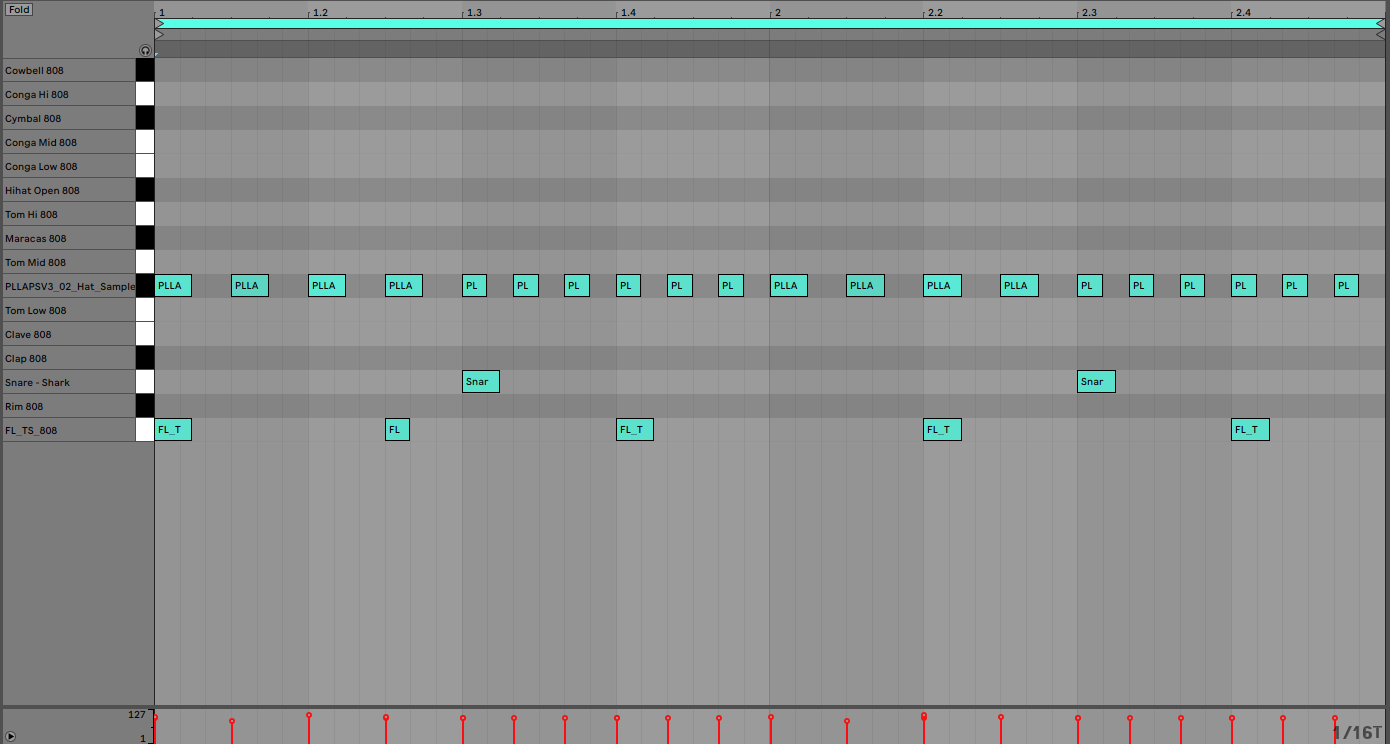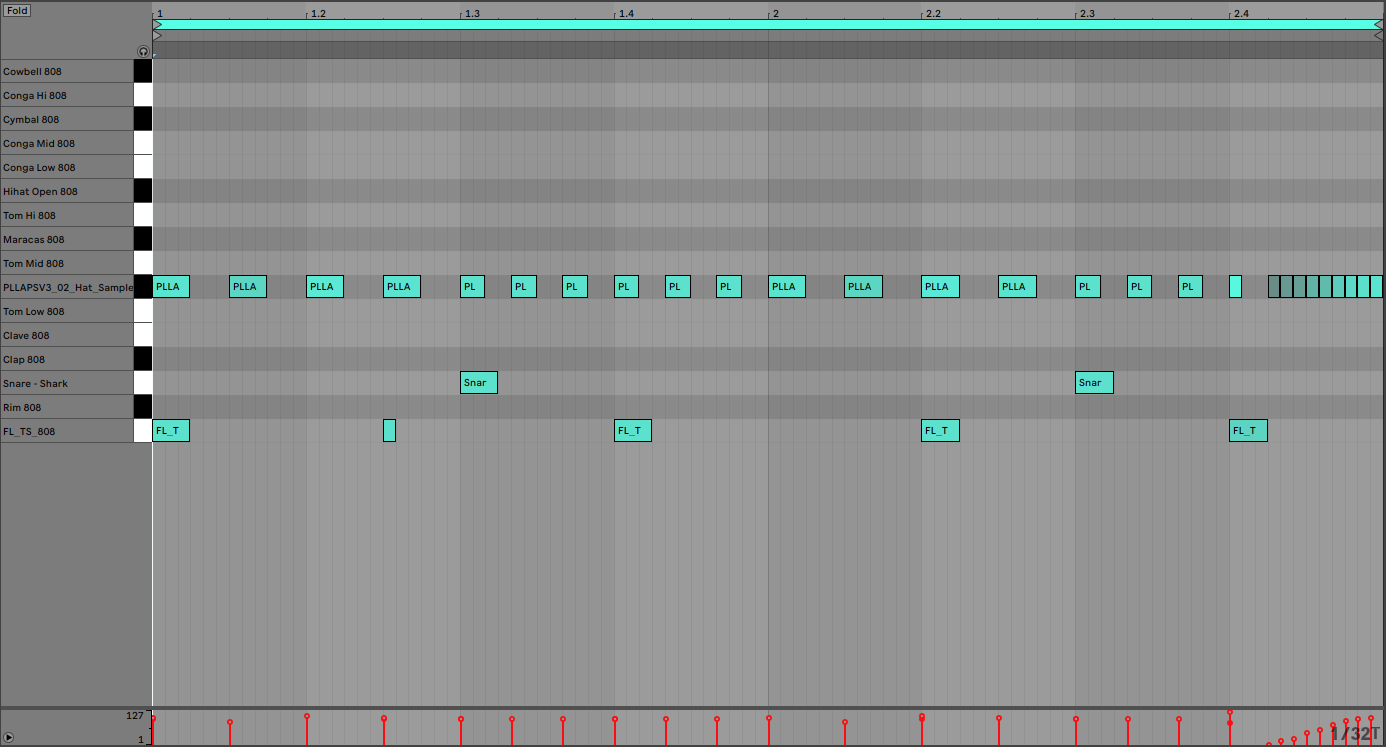Trap hats are instantly recognizable.
Just walk down a busy street and you’ll hear them clicking away in someone’s car.
They’re fast and they’re rhythmically complex, so it takes a bit of practice to get them right.
But finding a unique trap hat sound can be creatively inspiring– entire trap subgenres like Drill and Footwork have been spawned by variations in trap hat rhythms, speed, and tone.
In this article, we’ll unpack the rhythmic qualities commonly heard in trap hats, how to create them in your DAW, and how to get creative with trap hats in your own beats.
Trap hat basics– triplets, rolls, pitch and swing
The dividing line that separates trap hi-hats from hip hop hi-hats, is their level of complexity.
Specifically, it’s their use of four rhythmic ideas you won’t find very much in old school hip hop– triplets, rolls, pitch and swing.
Trap hats use four rhythmic ideas you won’t find very much in old school hip hop– triplets, rolls, pitch and swing.
Triplets upend the beat by adding an extra note to create rhythmic phrases that are felt in threes instead of twos.
It’s what gives trap hats those interesting off-kilter rhythmic qualities.
Rolls take the triplet idea but increase their speed by doubling or tripling their note value.
Putting a roll in the right place can help to accentuate the beat and create interesting and complex rhythms.
Swing is used in trap hats to take those parts of a beat that are written in duples (ONE-two feel) and make them fit within the context of a triplet feel.
Pitch automation is used to shift the tone of a track’s hi-hats up or down, they’re most often used to accentuate rolls.
When you master the four basic concepts of trap hats– triplets, rolls, pitch and swing you’ll have the ingredients you need to make hard-hitting and unique trap hats for your beats.
Triplets applied to trap
To learn how trap hats work it helps to have a basic foundation in rhythmic music theory.
But as a very basic crash course, triplets are groups of notes that are felt in threes instead of twos.
As a very basic crash course, triplets are groups of notes that are felt in threes instead of twos.
Most hip hop music in the ’90s and early 2000s, with a few exceptions, focus on that one-two duplet feel.
It makes sense since a lot of hip hop samples came from genres which mainly focussed on duple feel and syncopation in sixteenth notes.
Today’s trap music takes that duple feel and upends it by adding triplets into the rhythm.
Here’s what that duple feel sounds and looks like in a DAW editor.
Notice how in the bottom grid I’m using a sixteenth note view, in Ableton this is denoted by the 1/16 note value marker in the bottom right.
Each rectangle in the grid represents a single sixteenth note, so because im only using notes on every other rectangle these notes are called eighth notes.
I added a kick and snare part to the hi-hat rhythm to help frame the beat. Here’s what it sounds like so far.
https://blog.landr.com/wp-content/uploads/2020/02/Straight-Quarters.wav
Pretty simple right?
Trap hats take that ONE-and, TWO-and, THREE-and, FOUR-and feel and adds extra notes to some of the duplets.
A trap hat beat might add two notes to make two triplets in a bar. For example– ONE-and, TWO-and-a, THREE-and-a, FOUR-and.
Here’s what that looks like in a DAW.

Notice those shorter groups of three? Those are triplets!
To make triplets in your DAW editor make sure you’ve entered the triplet grid.
In this case, I am using a sixteenth note triplet grid, denoted by 1/16T marker in the bottom right.
With the new triplets, here’s what my beat sounds like now:
https://blog.landr.com/wp-content/uploads/2020/02/Eight-Note-Triples.wav
Rolling up to the pulse
Cool, we have a sweet little triplet pattern. Now it’s time to add some flare.
One of the most innovative aspects of trap music today is the rolling hi-hats you hear in trap sub-genres like drill and footwork.
The key to getting rolls right is putting them in rhythmically appropriate places where they complement the pulse of the beat.
The key to getting rolls right is putting them in rhythmically appropriate places where they complement the pulse of the beat.
To some, trap hi-hats may sound random and sporadic. But if you listen carefully you can hear what beats the producer is trying to accentuate with a roll.
Of course, there are many ways to use rolls to accentuate different beats!
In this beat, I’ll use a roll to emphasize the starting note (beat one) of my drum loop by adding a roll at the very end.
Making sure that my DAW editor’s grid is now in an even shorter 32nd triplet note grid let’s add a roll line and fill in the last full quarter note section of my beat.
Here’s what it looks like in my DAW.

To make the beat more rhythmic and less of an assault on my ears I added a small crescendo in volume over the roll.
To make the beat more rhythmic and less of an assault on my ears I added a small crescendo over the roll.
This crescendo does a nice job of ramping up my roll towards beat one of my loop which should be emphasized to drive the pulse along.
You can visualize my crescendo with the red volume markers that control the level of each beat.
Here’s what my beat sounds like with a roll.
https://blog.landr.com/wp-content/uploads/2020/02/Roll-Example.wav
Add a little DAW swing
I have some triplets and a tasty roll at the end of my beat, that’s great but there’s something missing.
Personally, I don’t like how straight and robotic this beat sounds.
I think adding some DAW swing to my trap hats makes sense since it will help the duple groups fit into and complement the triplet based sections.
But we’re getting into the personal taste zone here. Some producers love using really straight beats with no swing at all.
Here’s what my track sounds like with a little bit of DAW swing.
https://blog.landr.com/wp-content/uploads/2020/02/Add-Swing.wav
Getting creative with pitch, samples, and vocals
With triplets, rolls, and swing you have the basic tools to make trap hats for a trap beat.
But that’s just the start.
You can alter your trap hats in an infinite number of ways.
You can alter your trap hats in an infinite number of ways.
A lot of trap producers like to play with pitched hi-hats, especially on rolls.
For example you can hear pitch-shifting high hats in Migos’ Motorsport which was produced by Murda Beatz.
There’s a few different ways to play with pitches on your hi-hats in your DAW.
Producers use automation, a secondary hi-hat sound, or they’ll “play” hi-hats on a pitched keyboard in their own MIDI track.
Playing with roll placement is also really fun, especially when working with a sample or rap vocal.
You’ll discover that listening to the other rhythmic elements in your track will tell you where to put rolls and triplets.
For this track, I’ll use automation to pitch-shift my hi-hats.
I’ll put a cool sample I found in this Trap Top 50 pack over my drum track and I’ll move around the rolls a little bit to add some extra rhythmic character.
Here’s the final product in my DAW.

This is the final version of my track, so I’ll master it too.
Here’s what it sounds like now.
https://blog.landr.com/wp-content/uploads/2020/02/LANDR-Trap-Beat-Final-High-Open.wav
Advanced techniques and inspiration
So far we’ve looked at trap hi-hats in the 4/4 time signature.
But what about trap hats in other time signatures?
For example, you could add another dimension to the triplet concept by using a triple meter time signature like 6/8 or 12/8.
That’s where the inspiration for footwork style trap comes from, this trap subgenre really plays with triplets within the context of triple meter.
Try counting to Rashad’s track Drank, Kush, Barz– it’s constantly changing between a pulse felt in three and a pulse felt in four.
Another inspiring producer to look at also comes from Chicago. Young Chop is a legend for creating the drill sound.
In drill, hi-hat rolls are creatively used in abundance. Almost every element of a drill beat involves a rolled hi-hat.
Just listen to how hard-hitting the rolls are in Chief Keef’s I Don’t Like.
Now it’s your turn to make trap hats that slap
Now you have some simple concepts that you can apply in your DAW to add trap hats your next track.
Remember, these are concepts that are used by all the producers in the game.
The pros are so good because they know to take these concepts and turn them into something special and unique to their own sound.
Getting good at making trap hat beats that really stick out and complement the accompanying samples and vocals your track uses will take practice and creativity.
Take time to learn how automation and audio effects can change your sound.
Listen to and watch how other producers use trap hi-hats to accentuate parts of a track.
But most of all, sit down in your studio, start making beats and stay inspired!